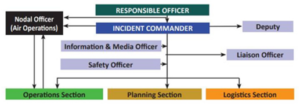Context: According to National Disaster Management Authority (NDMA), several states and Union territories (UTs) are yet to implement the Incident Response System (IRS), which is crucial for disaster response.
About Incident Response System (IRS):

News Source: HT
- It envisages a composite team with various Sections to attend to all the possible response requirements to a disaster.
- The IRS designates officers to perform various duties and get them trained in their respective roles.
- It emphasizes the need for proper documentation of various activities for better planning, accountability and analysis.
- This will greatly help in reducing chaos and confusion during the response phase.
- National Disaster Management Authority (NDMA) has issued the Guidelines on the Incident Response System (IRS) under Section 6 of the DM Act, 2005.
- AIm: Effective, efficient and comprehensive management of disasters in India.
- Vision of IRS: To minimize loss of life and property by strengthening and standardising the disaster response mechanism in the country.
- It is an effective mechanism for reducing ad-hoc measures in response.
- IRS Organisation:

Image Source: NDMA
- Organisational Flexibility: The IRS is a flexible system and all its Sections need not be activated in every situation at the same time.
- Only required sections may be made operational as and when required.
- This system envisages that the roles and duties shall be laid down in advance, the personnel earmarked and trained in their respective roles and duties.
National Disaster Management Authority (NDMA)
|
Post Views: 209
